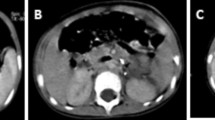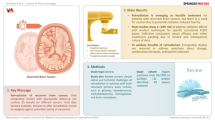Abstract
Cavernous malformations (CM) are cerebral irradiation-related late complications. Little is known about their natural history and the pathogenetic role of concomitant chemotherapy. We present a retrospective, single-institution study of 108 children affected with medulloblastoma, ependymoma, or germinoma treated with radio- and chemotherapy. The frequency, clinical and radiological presentations, and outcomes were analyzed to investigate the relationship among radiation dose, associated chemotherapy, age, latency and localization of radiation-induced CM. 100 out of 108 children were treated with radiotherapy for primary brain tumor; 34 (27 with medulloblastoma and 7 with other histologies) out of 100 patients developed CM. No significant relationship was found between CM and gender (p = 0.70), age (p = 0.90), use of specific chemotherapy (standard versus high-dose, p = 0.38), methotrexate (p = 0.49), and radiation dose (p = 0.45). However, CM developed more frequently and earlier when radiotherapy was associated with methotrexate (70 % of cases). Radiation-induced CM prevailingly occurred in the cerebral hemispheres (p = 0.0001). Only 3 patients (9 %) were symptomatic with headache. Three patients underwent surgery for intra- or extra-lesional hemorrhage. CM was confirmed by histopathology for all 3 patients. The vast majority of radiation-induced CM is asymptomatic, and macro-hemorrhagic events occur rarely. Concomitant therapy with methotrexate seems to favor their development. We recommend observation for asymptomatic lesions, while surgery should be reserved to symptomatic growth or hemorrhage.


Similar content being viewed by others
References
Schultheiss TE, Stephens LC (1992) Invited review: permanent radiation myelopathy. Br J Radiol 65(777):737–753
Ciricillo SF, Cogen PH, Edwards MS (1994) Pediatric cryptic vascular malformations: presentation, diagnosis and treatment. Pediatr Neurosurg 20(2):137–147
Gaensler EH, Dillon WP, Edwards MS, Larson DA, Rosenau W, Wilson CB (1994) Radiation-induced telangiectasia in the brain simulates cryptic vascular malformations at MR imaging. Radiology 193(3):629–636
Poussaint TY, Siffert J, Barnes PD, Pomeroy SL, Goumnerova LC, Anthony DC, Sallan SE, Tarbell NJ (1995) Hemorrhagic vasculopathy after treatment of central nervous system neoplasia in childhood: diagnosis and follow-up. Am J Neuroradiol 16(4):693–699
Pozzati E, Giangaspero F, Marliani F, Acciarri N (1996) Occult cerebrovascular malformations after irradiation. Neurosurgery 39(4):677–682
Humpl T, Brühl K, Bohl J, Schwarz M, Stoeter P, Gutjahr P (1997) Cerebral haemorrhage in long-term survivors of childhood acute lymphoblastic leukaemia. Eur J Pediatr 156(5):367–370
Novelli PM, Reigel DH, Langham Gleason P, Yunis E (1997) Multiple cavernous angiomas after high-dose whole-brain radiation therapy. Pediatr Neurosurg 26(6):322–325
Larson JJ, Ball WS, Bove KE, Crone KR, Tew JM Jr (1998) Formation of intracerebral cavernous malformations after radiation treatment for central nervous system neoplasia in children. J Neurosurg 88(1):51–56
Maeder P, Gudinchet F, Meuli R, de Tribolet N (1998) Development of a cavernous malformation of the brain. Am J Neuroradiol 19(6):1141–1143
Chang SD, Vanefsky MA, Havton LA, Silverberg GD (1998) Bilateral cavernous malformations resulting from cranial irradiation of a choroid plexus papilloma. Neurol Res 20(6):529–532
Alexander MJ, DeSalles AA, Tomiyasu U (1998) Multiple radiation-induced intracranial lesions after treatment for pituitary adenoma: case report. J Neurosurg 88(1):111–115
Amirjamshidi A, Abbassioun K (2000) Radiation-induced tumors of the central nervous system occurring in childhood and adolescence. Four unusual lesions in three patients and a review of the literature. Childs Nerv Syst 16(7):390–397
Olivero WC, Deshmukh P, Gujrati M (2000) Radiation-induced cavernous angioma mimicking metastatic disease. Br J Neurosurg 14(6):575–578
Heckl S, Aschoff A, Kunze S (2002) Radiation-induced cavernous hemangiomas of the brain: a late effect predominantly in children. Cancer 94(12):3285–3291
Noël L, Christmann D, Jacques C, Kehrli P, Grebici-Guessom M, Esposito P, Ding XY, Marin H, Bogorin A, Zöllner G, Dietemann JL (2002) Intracerebral radiation-induced cavernous angiomas. J Neuroradiol 29(1):49–56
Baumgartner JE, Ater JL, Ha CS, Kuttesch JF, Leeds NE, Fuller GN, Wilson RJ (2003) Pathologically proven cavernous angiomas of the brain following radiation therapy for pediatric brain tumors. Pediatr Neurosurg 39(4):201–207
Van Calenbergh F, Demaerel P, Sciot R, van Loon J (2003) Acquired cerebellar cavernous angioma following childhood radiotherapy in a patient with neurofibromatosis type 1. Acta Neurol Belg 103(2):103–106
Jabbour P, Gault J, Murk SE, Awad IA (2004) Multiple spinal cavernous malformations with atypical phenotype after prior irradiation: case report. Neurosurgery 55(6):1431
Campeau NG, Lane JI (2005) De novo development of a lesion with the appearance of a cavernous malformation adjacent to an existing developmental venous anomaly. Am J Neuroradiol 26(1):156–159
Jain R, Robertson PL, Gandhi D, Gujar SK, Muraszko KM, Gebarski S (2005) Radiation-induced cavernomas of the brain. Am J Neuroradiol 26(5):1158–1162
Duhem R, Vinchon M, Leblond P, Soto-Ares G, Dhellemmes P (2005) Cavernous malformations after cerebral irradiation during childhood: report of nine cases. Childs Nerv Syst 21(10):922–925
Furuse M, Miyatake SI, Kuroiwa T (2005) Cavernous malformation after radiation therapy for astrocytoma in adult patients: report of 2 cases. Acta Neurochir (Wien) 147(10):1097–1101
Nyáry I, Major O, Hanzély Z, Szeifert GT (2005) Histopathological findings in a surgically resected thalamic cavernous hemangioma 1 year after 40-Gy irradiation. J Neurosurg 102:56–58
Lew SM, Morgan JN, Psaty E, Lefton DR, Allen JC, Abbott R (2006) Cumulative incidence of radiation-induced cavernomas in long-term survivors of medulloblastoma. J Neurosurg 104(2 Suppl):103–107
Burn S, Gunny R, Phipps K, Gaze M, Hayward R (2007) Incidence of cavernoma development in children after radiotherapy for brain tumors. J Neurosurg 106(5 Suppl):379–383
Martínez-Lage JF, de la Fuente I, de San Ros, Pedro J, Fuster JL, Pérez-Espejo MA, Herrero MT (2008) Cavernomas in children with brain tumors: a late complication of radiotherapy. Neurocirugia (Astur) 19(1):50–54
Consales A, Piatelli G, Ravegnani M, Pavanello M, Striano P, Zoli ML, Capra V, Rossi A, Garrè ML, Calevo MG, Cama A (2009) Treatment and outcome of children with cerebral cavernomas: a survey on 32 patients. Neurol Sci 31(2):117–123
Faraci M, Morana G, Bagnasco F, Barra S, Polo P, Hanau G, Fioredda F, Caruso S, Rossi A, Spaziante R, Haupt R (2010) Magnetic resonance imaging in childhood leukemia survivors treated with cranial radiotherapy: a cross sectional, single center study. Pediatr Blood Cancer 57(2):240–246
Bergametti F, Denier C, Labauge P, Arnoult M, Boetto S, Clanet M, Coubes P, Echenne B, Ibrahim R, Irthum B, Jacquet G, Lonjon M, Moreau JJ, Neau JP, Parker F, Tremoulet M, Tournier-Lasserve E (2005) Mutations within the programmed cell death 10 gene cause cerebral cavernous malformations. Am J Hum Genet 76(1):42–51
Robinson JR, Awad IA, Little JR (1991) Natural history of the cavernous angioma. J Neurosurg 75(5):709–714
Kim DS, Park YG, Choi JU, Chung SS, Lee KC (1997) An analysis of the natural history of cavernous malformations. Surg Neurol 48(1):9–17 discussion 17-8
Al-Holou WN, O’Lynnger TM, Pandey AS, Gemmete JJ, Thompson BG, Muraszko KM, Garton HJ, Maher CO (2012) Natural history and imaging prevalence of cavernous malformations in children and young adults. J Neurosurg Pediatr 9(2):198–205
Nimjee SM, Powers CJ, Bulsara KR (2006) Review of the literature on de novo formation of cavernous malformations of the central nervous system after radiation therapy. Neurosurg Focus 21(1):e4
Keezer MR, Del Maestro R (2009) Radiation-induced cavernous hemangiomas: case report and literature review. Can J Neurol Sci 36(3):303–310
Koike T, Yanagimachi N, Ishiguro H, Yabe H, Yabe M, Morimoto T, Shimizu T, Takakura H, Kato S (2012) High incidence of radiation-induced cavernous hemangioma in long-term survivors who underwent hematopoietic stem cell transplantation with radiation therapy during childhood or adolescence. Biol Blood Marrow Transpl 18(7):1090–1098
Kiliç T, Pamir MN, Küllü S, Eren F, Ozek MM, Black PM (2000) Expression of structural proteins and angiogenic factors in cerebrovascular anomalies. Neurosurgery 46(5):1179–1191
Corapçioğlu F, Akansel G, Gönüllü E, Yildiz K, Etuş V (2006) Fatal giant pediatric intracranial cavernous angioma. Turk J Pediatr 48(1):89–92
Menon RN, Baheti NN, Cherian A, Rathore C, Iyer RS, Radhakrishnan A (2011) Post-irradiation “acquired cavernous angiomas” with drug resistant seizures. Epilepsy Res 96(1–2):161–165
Simard JM, Garcia-Bengochea F, Ballinger WE Jr, Mickle JP, Quisling RG (1986) Cavernous angioma: a review of 126 collected and 12 new clinical cases. Neurosurgery 18(2):162–172
Del Curling O, Jr Kelly DL Jr, Elster AD, Craven TE (1991) An analysis of the natural history of cavernous angiomas. J Neurosurg 75(5):702–708
Sigal R, Krief O, Houtteville JP, Halimi P, Doyon D, Pariente D (1990) Occult cerebrovascular malformations: follow-up with MR imaging. Radiology 176(3):815–819
Kim DS, Park YG, Choi JU, Chung SS, Lee KC (1997) An analysis of the natural history of cavernous malformations. Surg Neurol 48(1):9–17
Porter PJ, Willinsky RA, Harper W, Wallace MC (1997) Cerebral cavernous malformations: natural history and prognosis after clinical deterioration with or without hemorrhage. J Neurosurg 87(2):190–197
Moriarity JL, Clatterbuck RE, Rigamonti D (1999) The natural history of cavernous malformations. Neurosurg Clin N Am 10(3):411–417
Al-Shahi Salman R, Berg MJ, Morrison L, Awad IA, Angioma Alliance Scientific Advisory Board (2008) Hemorrhage from cavernous malformations of the brain: definition and reporting standards. Angioma Alliance Scientific Advisory Board. Stroke 39(12):3222–3230
Di Rocco C, Iannelli A, Tamburrini G (1996) Cavernomas of the central nervous system in children. A report of 22 cases. Acta Neurochir (Wien) 138(11):1267–1274 Discussion 1273-4
Kishi S, Griener J, Cheng C, Das S, Cook EH, Pei D, Hudson M, Rubnitz J, Sandlund JT, Pui CH, Relling MV (2003) Homocysteine, pharmacogenetics, and neurotoxicity in children with leukemia. J Clin Oncol 21(16):3084–3091
Harila-Saari AH, Ahonen AK, Vainionpää LK, Pääkkö EL, Pyhtinen J, Himanen AS, Torniainen PJ, Lanning BM (1997) Brain perfusion after treatment of childhood acute lymphoblastic leukemia. J Nucl Med 38(1):82–88
Scott RM, Barnes P, Kupsky W, Adelman LS (1992) Cavernous angiomas of the central nervous system in children. J Neurosurg 76(1):38–46
Tew JM Jr, Lewis AI, Reichert KW (1995) Management strategies and surgical techniques for deep-seated supratentorial arteriovenous malformations. Neurosurgery 36(6):1065–1072
Acknowledgement
We thank The “Associazione per la ricerca sui Tumori Cerebrali del Bambino” and The “Fondazione Berlucchi” for supporting our research.
Author information
Authors and Affiliations
Corresponding author
Rights and permissions
About this article
Cite this article
Di Giannatale, A., Morana, G., Rossi, A. et al. Natural history of cavernous malformations in children with brain tumors treated with radiotherapy and chemotherapy. J Neurooncol 117, 311–320 (2014). https://doi.org/10.1007/s11060-014-1390-9
Received:
Accepted:
Published:
Issue Date:
DOI: https://doi.org/10.1007/s11060-014-1390-9




